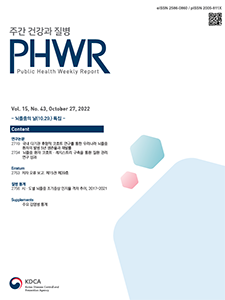Current Issue
Vol.15 No.43, October 27, 2022
-
Original Articles 2022-10-27
 4
4
 475
475
 125
125
The Long-term Survival and Recurrence Rate of Stroke Patients in Korea: the Multicenter Prospective Cohort Study
Seyoung Shin, Won Hyuk Chang, Deog Young Kim, Jongmin Lee, Min Kyun Sohn, Min-Keun Song, Yong-Il Shin, Yang-Soo Lee, Min Cheol Joo, So Young Lee, Jeonghoon Ahn, Gyung-Jae Oh, Young Hoon Lee, Junhee Han, Yun-Hee Kim
Public Health Weekly Report 2022; 15(43): 2719-2733 https://doi.org/10.56786/PHWR.2022.15.43.2719 Abstract
AbstractThe purpose of this study was to report five-year survival and recurrence rate after first-time stroke using the data obtained by multicenter prospective cohort study in Korea. This study was an interim analysis of the Korean Stroke Cohort for Functioning and Rehabilitation (KOSCO). Data of 10,636 first-time stroke patients (8,210 ischemic and 2,426 hemorrhagic) who were admitted to the 9 district hospitals of Korea were analyzed. In order to compensate the missing values due to the follow-up failure, KOSCO data were linked with the National Health Insurance Service data until 2020. Mortality and recurrence rate up to five years were estimated by Kaplan–Meier estimation and the Cox regression analysis. The one-year cumulative mortality rate was 11.8%, the three-year 18.9%, and the five-year 25.2%. Hemorrhagic stroke, female, older age, combined diseases, hypertension, in-hospital pneumonia, lack of intensive rehabilitation, moderate to severe initial stroke severity ( National Institutes of Health Stroke Scale >15), low initial motor function ( Fugl-Meyer Assessment <85), and low ambulatory functions (Functional Ambulatory Category 0–3) showed higher hazard ratio for mortality (p<0.05). The one-year cummulative recurrence rate was 8.9%, the three-year 12.7%, and the five-year 15.5%. According to Cox regression analysis, stroke type (ischemic) and initial stroke severity were significant factors for stroke recurrence (p<0.05). Of the factors affecting 5-year mortality after first-time stroke, two modifiable factors were defined as pneumonia and intensive rehabilitation during the first admission period.
-
Original Articles 2022-10-27
 0
0
 868
868
 160
160
The Results of a Study on the Management of Acute Ischemic Stroke by Establishing a Nationwide Cohort and Registry in Korea
Eung-Joon Lee, Do Yeon Kim, Han-Yeong Jeong, Keon-Joo Lee, Hye-Kyung Lee, Young-Ho Koh, Keun-Hwa Jung, Hee-Joon Bae, Jong-Moo Park
Public Health Weekly Report 2022; 15(43): 2734-2752 https://doi.org/10.56786/PHWR.2022.15.43.2734 Abstract
AbstractThe aim of this study is to produce standardized statistics about stroke in Korea and to provide a high-quality standardized management system. This study was conducted with two sub-studies. The first sub-study had the purpose of registration of stroke patients to a structured cohort (Clinical Research Collaboration for Stroke-Korea-National Institute of Health) and long-term follow-up. The second sub-study was directed to organize, operate, and manage the Korea Stroke Registry. During the 5-year of the study period, 25,515 patients from 17 hospitals were enrolled in the cohort, and blood samples from 360 patients with arterial dissection and transient ischemic attack were deposited with the National Human Resources Bank. In addition, a 3-year long-term follow-up cohort was prepared. Korean Stroke Registry started with 43 hospitals and expanded with more than 25 centers expected to be participating, and a total of 66,701 patients from 55 hospitals were registered. Promotions for enrolling more hospitals, and establishing multiple patient data input systems, open proposal systems, and Korea stroke registry core database quality improvement systems were done. In addition, the annual report on Korean stroke registration was published. Through this study, we laid the basis for further stroke-related research by establishing acute stroke cohort and registry. It is hoped that this cohort and registry would be useful in the process of obtaining national statistics on stroke, which will eventually serve as the basis for policy research to build a "Stroke safety net".
-
QuickStats 2022-10-27
 0
0
 77
77
 29
29
Trends in the Gap between Metropolitan Cities in the Early Recognition of Symptoms of Stroke, 2017–2021
Public Health Weekly Report 2022; 15(43): 2756-2757 https://doi.org/10.56786/PHWR.2022.15.43.2756

pp. 1433~1461
Most Keyword
?
What is Most Keyword?
- It is the most frequently used keyword in articles in this journal for the past two years.
Most Read
-
Waterborne and Foodborne Disease Outbreaks in the Republic of Korea, 2023
Myung-Jae Hwang, So Yeon Park, Hyungjun Kim, Se Jeong Yang, Sungchan Yang, Jin Seon Yang
Public Health Weekly Report 2025;18: 17-32 https://doi.org/10.56786/PHWR.2025.18.1.2 -
Implementation Plan for the Coronavirus Disease 2019 Vaccination for the 2024–2025 Season: Recommendations of the 6th Expert Committee on Immunization Practices
Hyewook Hwang, Wookeon Lee, Seohyeon Ahn, Young-Sook Choi, Seunghyun Lewis Kwon, Dongwoo Lee, Eun Hwa Choi, SokGoo Lee
Public Health Weekly Report 2025;18: 90-102 https://doi.org/10.56786/PHWR.2025.18.2.3
Editorial Office
+82-43-719-7569





 Full Text
Full Text Cite
Cite


